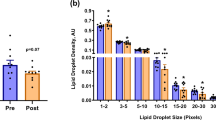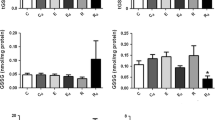Abstract
Past studies have suggested that the stress-induced GLUT4 localization pathway is damaged in fast-twitch muscles (white muscles) of obese subjects. In this study, we used obese rodents in an attempt to determine whether the stress-induced GLUT4 localization pathway is abnormal in slow-twitch muscles (red muscles), which are responsible for most daily activities. Protein expression levels of the intracellular stress sensor AMP-activated protein kinase (AMPK), its upstream kinase LKB1, its downstream protein AS160 and the glucose transporter protein 4 (GLUT4) in the red gastrocnemius muscle were measured under either resting or stress conditions (1 h of swimming or 14% hypoxia) in both lean and obese Zucker rats (n = 7 for each group). At rest, obese rats displayed higher fasting plasma insulin levels and increased muscle AMPK and AS160 phosphorylation levels compared with lean controls. No significant difference was found in the protein levels of LKB1, total GLUT4, or membrane GLUT4 between the obese and lean control groups. After one hour of swimming, AMPK and AS160 phosphorylation levels and the amount of GLUT4 translocated to the plasma membrane were significantly elevated in lean rats but remained unchanged in obese rats relative to their resting conditions. One hour 14% hypoxia did not cause significant changes in the LKB1-AMPK-AS160-GLUT4 pathway in either lean or obese rats. This study demonstrated that the AMPK-AS160-GLUT4 pathway was altered at basal levels and after exercise stimulation in the slow-twitch muscle of obese Zucker rats.






Similar content being viewed by others
References
Anai M, Funaki M, Ogihara T, Terasaki J, Inukai K, Katagiri H, Fukushima Y, Yazaki Y, Kikuchi M, Oka Y, Asano T (1998) Altered expression levels and impaired steps in the pathway to phosphatidylinositol 3-kinase activation via insulin receptor substrates 1 and 2 in Zucker fatty rats. Diabetes 47:13–23
Barnes BR, Ryder JW, Steiler TL, Fryer LG, Carling D, Zierath JR (2002) Isoform-specific regulation of 5' AMP-activated protein kinase in skeletal muscle from obese Zucker (fa/fa) rats in response to contraction. Diabetes 51:2703–2708
Chiu LL, Chou SW, Cho YM, Ho HY, Ivy JL, Hunt D, Wang PS, Kuo CH (2004) Effect of prolonged intermittent hypoxia and exercise training on glucose tolerance and muscle GLUT4 protein expression in rats. J Biomed Sci 11:838–846
DeFronzo RA, Jacot E, Jequier E, Maeder E, Wahren J, Felber JP (1981) The effect of insulin on the disposal of intravenous glucose. Results from indirect calorimetry and hepatic and femoral venous catheterization. Diabetes 30:1000–1007
de Lange P, Moreno M, Silvestri E, Lombardi A, Goglia F, Lanni A (2007) Fuel economy in food-deprived skeletal muscle: signaling pathways and regulatory mechanisms. FASEB J 21:3431–3441
Dominiczak MH (2003) Obesity, glucose intolerance and diabetes and their links to cardiovascular disease. Implications for laboratory medicine. Clin Chem Lab Med 41:1266–1278
Fisher JS, Gao J, Han DH, Holloszy JO, Nolte LA (2002) Activation of AMP kinase enhances sensitivity of muscle glucose transport to insulin. Am J Physiol Endocrinol Metab 282:E18–E23
Fujii N, Jessen N, Goodyear LJ (2006) AMP-activated protein kinase and the regulation of glucose transport. Am J Physiol Endocrinol Metab 291:E867–E877
Hardie DG, Sakamoto K (2006) AMPK: a key sensor of fuel and energy status in skeletal muscle. Physiology (Bethesda) 21:48–60
Hayashi T, Hirshman MF, Kurth EJ, Winder WW, Goodyear LJ (1998) Evidence for 5′ AMP-activated protein kinase mediation of the effect of muscle contraction on glucose transport. Diabetes 47:1369–1373
Kerouz NJ, Hörsch D, Pons S, Kahn CR (1997) Differential regulation of insulin receptor substrates-1 and -2 (IRS-1 and IRS-2) and phosphatidylinositol 3-kinase isoforms in liver and muscle of the obese diabetic (ob/ob) mouse. J Clin Invest 100:3164–3172
Kramer HF, Witczak CA, Fujii N, Jessen N, Taylor EB, Arnolds DE, Sakamoto K, Hirshman MF, Goodyear LJ (2006) Distinct signals regulate AS160 phosphorylation in response to insulin, AICAR, and contraction in mouse skeletal muscle. Diabetes 55:2067–2076
Krook A, Wallberg-Henriksson H, Zierath JR (2004) Sending the signal: molecular mechanisms regulating glucose uptake. Med Sci Sports Exerc 36:1212–1217
Meyer MM, Levin K, Grimmsmann T, Beck-Nielsen H, Klein HH (2002) Insulin signalling in skeletal muscle of subjects with or without type II-diabetes and first degree relatives of patients with the disease. Diabetologia 45:813–822
Misra P (2008) AMP activated protein kinase: a next generation target for total metabolic control. Expert Opin Ther Targets 12:91–100
Musi N, Goodyear LJ (2003) AMP-activated protein kinase and muscle glucose uptake. Acta Physiol Scand 178:337–345
Pette D, Sparmer C (1986) Metabolic properties of muscle fibers. Fed Proc 45:2910–2914, Review
Rodnick KJ, Henriksen EJ, James DE, Holloszy JO (1992) Exercise training, glucose transporters, and glucose transport in rat skeletal muscles. Am J Physiol 262:C9–C14
Sakamoto K, McCarthy A, Smith D, Green KA, Grahame Hardie D, Ashworth A, Alessi DR (2005) Deficiency of LKB1 in skeletal muscle prevents AMPK activation and glucose uptake during contraction. EMBO J 24:1810–1820
Sriwijitkamol A, Coletta DK, Wajcberg E, Balbontin GB, Reyna SM, Barrientes J, Eagan PA, Jenkinson CP, Cersosimo E, DeFronzo RA (2007) Effect of acute exercise on AMPK signaling in skeletal muscle of subjects with type 2 diabetes: a time-course and dose-response study. Diabetes 56:836–848
Sriwijitkamol A, Ivy JL, Christ-Roberts C, DeFronzo RA, Mandarino LJ, Musi N (2006) LKB1-AMPK signaling in muscle from obese insulin-resistant Zucker rats and effects of training. Am J Physiol Endocrinol Metab 290:E925–E932
Taylor EB, Hurst D, Greenwood LJ, Lamb JD, Cline TD, Sudweeks SN, Winder WW (2004) Endurance training increases LKB1 and MO25 protein but not AMP-activated protein kinase activity in skeletal muscle. Am J Physiol Endocrinol Metab 287:E1082–E1089
Viollet B, Mounier R, Leclerc J, Yazigi A, Foretz M, Andreelli F (2007) Targeting AMP-activated protein kinase as a novel therapeutic approach for the treatment of metabolic disorders. Diabetes Metab 33:395–402
Wilber RL (2001) Current trends in altitude training. Sports Med 31(4):249–265
Woods A, Johnstone SR, Dickerson K, Leiper FC, Fryer LG, Neumann D, Schlattner U, Wallimann T, Carlson M, Carling D (2003) LKB1 is the upstream kinase in the AMP-activated protein kinase cascade. Curr Biol 13:2004–2008
Wu LY, Juan CC, Hwang LS, Hsu YP, Ho PH, Ho LT (2004) Green tea supplementation ameliorates insulin resistance and increases glucose transporter IV content in a fructose-fed rat model. Eur J Nutr 43:116–124
Acknowledgments
This study was supported by grants V97C1-026 and V98C1-006 from the Taipei Veterans General Hospital and grant NSC 97-2314-B075-013-MY3 from the National Science Council.
Author information
Authors and Affiliations
Corresponding author
Additional information
Chia-Hua Kuo and Low-Tone Ho equally contributed to this work.
Rights and permissions
About this article
Cite this article
Chen, YC., Lee, SD., Hsih, SY. et al. Perturbations of the stress-induced GLUT4 localization pathway in slow-twitch muscles of obese Zucker rats. J Physiol Biochem 67, 297–305 (2011). https://doi.org/10.1007/s13105-011-0075-5
Received:
Accepted:
Published:
Issue Date:
DOI: https://doi.org/10.1007/s13105-011-0075-5




